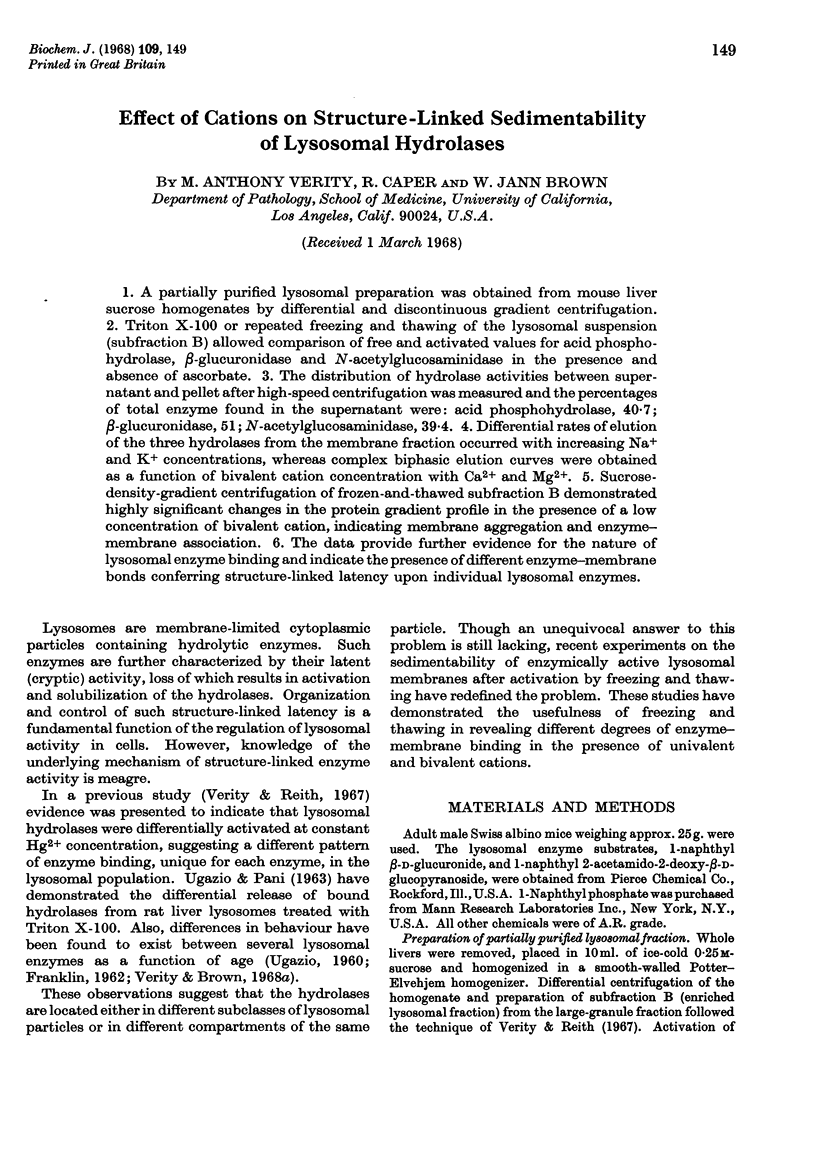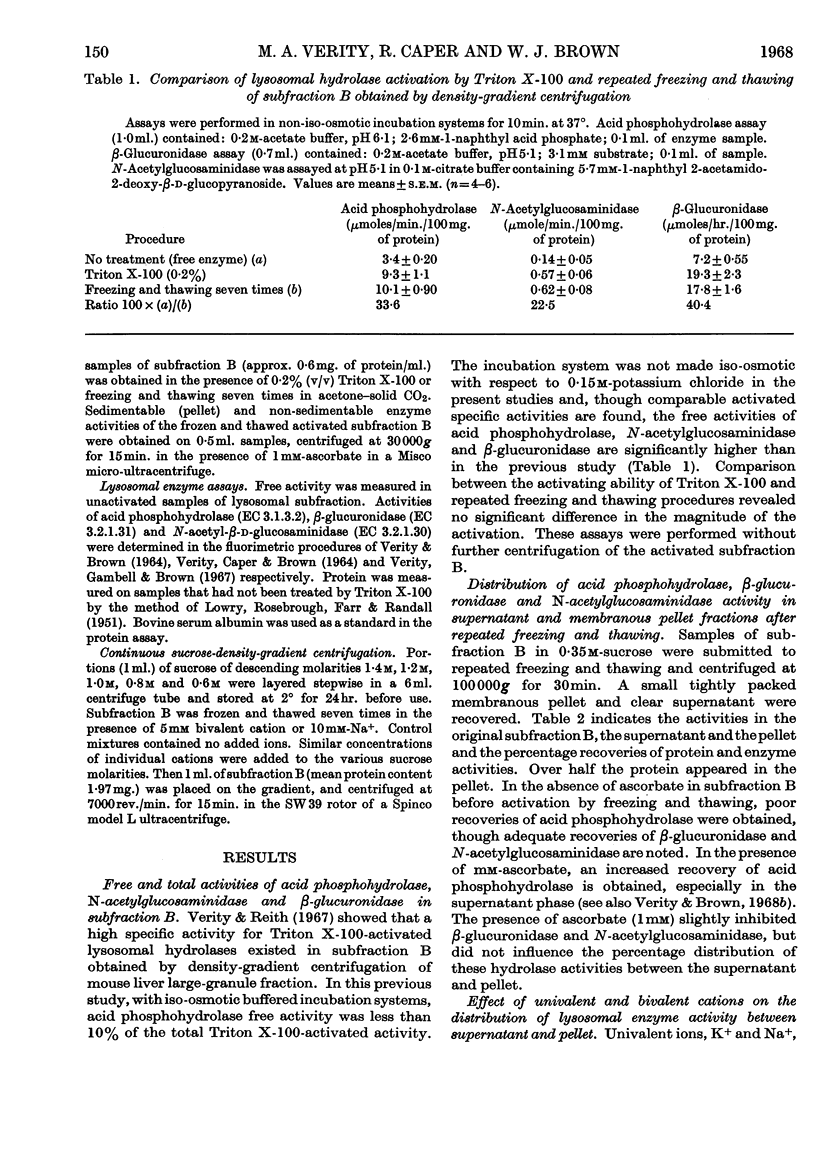Abstract
1. A partially purified lysosomal preparation was obtained from mouse liver sucrose homogenates by differential and discontinuous gradient centrifugation. 2. Triton X-100 or repeated freezing and thawing of the lysosomal suspension (subfraction B) allowed comparison of free and activated values for acid phosphohydrolase, β-glucuronidase and N-acetylglucosaminidase in the presence and absence of ascorbate. 3. The distribution of hydrolase activities between supernatant and pellet after high-speed centrifugation was measured and the percentages of total enzyme found in the supernatant were: acid phosphohydrolase, 40·7; β-glucuronidase, 51; N-acetylglucosaminidase, 39·4. 4. Differential rates of elution of the three hydrolases from the membrane fraction occurred with increasing Na+ and K+ concentrations, whereas complex biphasic elution curves were obtained as a function of bivalent cation concentration with Ca2+ and Mg2+. 5. Sucrose-density-gradient centrifugation of frozen-and-thawed subfraction B demonstrated highly significant changes in the protein gradient profile in the presence of a low concentration of bivalent cation, indicating membrane aggregation and enzyme–membrane association. 6. The data provide further evidence for the nature of lysosomal enzyme binding and indicate the presence of different enzyme–membrane bonds conferring structure-linked latency upon individual lysosomal enzymes.
Full text
PDF





Selected References
These references are in PubMed. This may not be the complete list of references from this article.
- APPELMANS F., DE DUVE C. Tissue fractionation studies. 3. Further observations on the binding of acid phosphatase by rat-liver particles. Biochem J. 1955 Mar;59(3):426–433. doi: 10.1042/bj0590426. [DOI] [PMC free article] [PubMed] [Google Scholar]
- Dallner G., Nilsson R. Mechanism of the cation effect in subfractionation of microsomes. J Cell Biol. 1966 Oct;31(1):181–193. doi: 10.1083/jcb.31.1.181. [DOI] [PMC free article] [PubMed] [Google Scholar]
- EGGER E., RAPOPORT S. ROLE OF NON-COVALENT BONDS FOR THE HOLDING, ACTIVATION AND RELEASE OF MITOCHONDRIAL ENZYMES. Nature. 1963 Oct 19;200:240–242. doi: 10.1038/200240a0. [DOI] [PubMed] [Google Scholar]
- FRANKLIN T. J. The influence of age on the activities of some acid hydrolases in the rat liver and kidney. Biochem J. 1962 Jan;82:118–122. doi: 10.1042/bj0820118. [DOI] [PMC free article] [PubMed] [Google Scholar]
- Fishman W. H., Goldman S. S., DeLellis R. Dual localization of beta-glucuronidase in endoplasmic reticulum and in lysosomes. Nature. 1967 Feb 4;213(5075):457–460. doi: 10.1038/213457a0. [DOI] [PubMed] [Google Scholar]
- GIANETTO R., DE DUVE C. Tissue fractionation studies. 4. Comparative study of the binding of acid phosphatase, beta-glucuronidase and cathepsin by rat-liver particles. Biochem J. 1955 Mar;59(3):433–438. doi: 10.1042/bj0590433. [DOI] [PMC free article] [PubMed] [Google Scholar]
- Holowach J., Howe M. C., Laatsch R. H., McDougal D. B., Jr Effects of various anions and cations on the release of four dehydrogenases from brain mitochondria by a non-ionic detergent. Biochim Biophys Acta. 1966 May 5;118(2):230–239. doi: 10.1016/s0926-6593(66)80032-2. [DOI] [PubMed] [Google Scholar]
- LOWRY O. H., ROSEBROUGH N. J., FARR A. L., RANDALL R. J. Protein measurement with the Folin phenol reagent. J Biol Chem. 1951 Nov;193(1):265–275. [PubMed] [Google Scholar]
- UGAZIO G., PANI P. DIFFERENTIAL RELEASE OF BOUND HYDROLASES FROM RAT-LIVER LYSOSOMES TREATED BY A NON-IONIC SURFACE ACTIVE SUBSTANCE. Exp Cell Res. 1963 Aug;31:424–427. doi: 10.1016/0014-4827(63)90019-3. [DOI] [PubMed] [Google Scholar]
- VAN LANCKER J. L., HOLTZER R. L. The fate of nuclei, deoxyribonucleic and deoxyribonuclease in the course of autolysis. Lab Invest. 1963 Jan;12:102–105. [PubMed] [Google Scholar]
- VERITY M. A., BROWN W. J. MURINE HEPATIC AND CEREBRAL LYSOSOMAL ACID PHOSPHOMONOESTERASES. Exp Cell Res. 1964 Jun;35:84–99. doi: 10.1016/0014-4827(64)90074-6. [DOI] [PubMed] [Google Scholar]
- VERITY M. A., CAPER R., BROWN W. J. SPECTROFLUOROMETRIC DETERMINATION OF BETA-GLUCURONIDASE ACTIVITY. Arch Biochem Biophys. 1964 Jul 20;106:386–393. doi: 10.1016/0003-9861(64)90205-x. [DOI] [PubMed] [Google Scholar]
- Verity M. A., Brown W. J. Structure-linked activity of lysosomal enzymes in the developing mouse brain. J Neurochem. 1968 Feb;15(2):69–80. doi: 10.1111/j.1471-4159.1968.tb06176.x. [DOI] [PubMed] [Google Scholar]
- Verity M. A., Gambell J. K., Brown W. J. Fluorometric determination of N-acetyl-beta-D-glucosaminidase activity. Arch Biochem Biophys. 1967 Feb;118(2):310–316. doi: 10.1016/0003-9861(67)90354-2. [DOI] [PubMed] [Google Scholar]
- Verity M. A., Reith A. Effect of mercurial compounds on structure-linked latency of lysosomal hydrolases. Biochem J. 1967 Nov;105(2):685–690. doi: 10.1042/bj1050685. [DOI] [PMC free article] [PubMed] [Google Scholar]
- WALLACH D. F., KAMAT V. B. PLASMA AND CYTOPLASMIC MEMBRANE FRAGMENTS FROM EHRLICH ASCITES CARCINOMA. Proc Natl Acad Sci U S A. 1964 Sep;52:721–728. doi: 10.1073/pnas.52.3.721. [DOI] [PMC free article] [PubMed] [Google Scholar]


